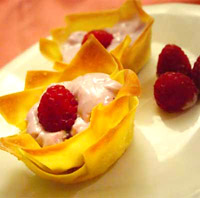This IS Restaurant
Updated: 2007-05-30 10:06
 As the local dining scene burgeons, patterns begin to emerge. Restaurateurs have the option of starting small, luring a targeted group of patrons with their mid-range fare; another option would be to go the whole hog and splash out on a multi-million yuan space in a swanky location with prices to match.
As the local dining scene burgeons, patterns begin to emerge. Restaurateurs have the option of starting small, luring a targeted group of patrons with their mid-range fare; another option would be to go the whole hog and splash out on a multi-million yuan space in a swanky location with prices to match.
A concept is another tool often employed, sometimes in tandem with the two strategies above. These joints brainstorm for ages and come up with a premise they hope is so irresistible it pulls in the crowds in droves.
IS Restaurant is hoping they have latched on to a winning formula.
Bordering on the ultra-pretentious, the New Factories establishment is decidedly focused on putting the "experience" in "dining experience." Part art concept, part fine-diner, there are moments when it is not exactly apparent what it is trying to be.
There are restaurants that immediately appeal to the visual senses, wowing you as soon as you walk in; sometimes with palatial decor, sometimes with sheer size. IS has gone for the cold, minimalist approach that exudes art-crowd cool.
It is no wonder, as the restaurant is the brainchild of General Manager Weng Yinlan and her husband, who is in the art business. Having started the concept in her native Guilin two years ago, the former advertising executive is confident that the concept will be a hit locally as well. "We do creative, fusion dishes that are appealing to the eye as much as they taste good," she said. "None of our serving ware is mass produced. Besides custom-made plates, we also use a lot of natural products, like pine needles for decorative plating."
"Some things, like acorns, are things that I've picked up myself from the countryside back in Guilin. You could never find stuff like this in Shanghai."
The design lives up to its billing. Words do little justice to the creative use of space on the top floor of this refurbished factory. Dried roots and branches form non-imposing barriers that partition the dining area; the centerpiece is a long, mirrored table with imposing, tall-backed chairs forming booths without being sealed off.
Neo-classical teapots and dings (an ancient Chinese tri-legged vessel) are displayed prominently with the similar furniture. Weng said that plans are afoot to hold art exhibitions and performances in the restaurant.
|
||
|
||
| Eating out:
Arriba arrives in the Wu
Bars&Cafes: Mare's milk a-go-go Weekend&Holiday: Ancient sites re-open after renovation Shopping: Jimmy Choo comes What's on: New shows on stage |
|
||
| Eating out:
Moroccan roll
Bars&Cafes: A boonna in training Weekend&Holiday: Pop power Shopping: LV boutique in E. China closed for disqualification What's on: Jazz-infused journey through Kunqu Opera |



